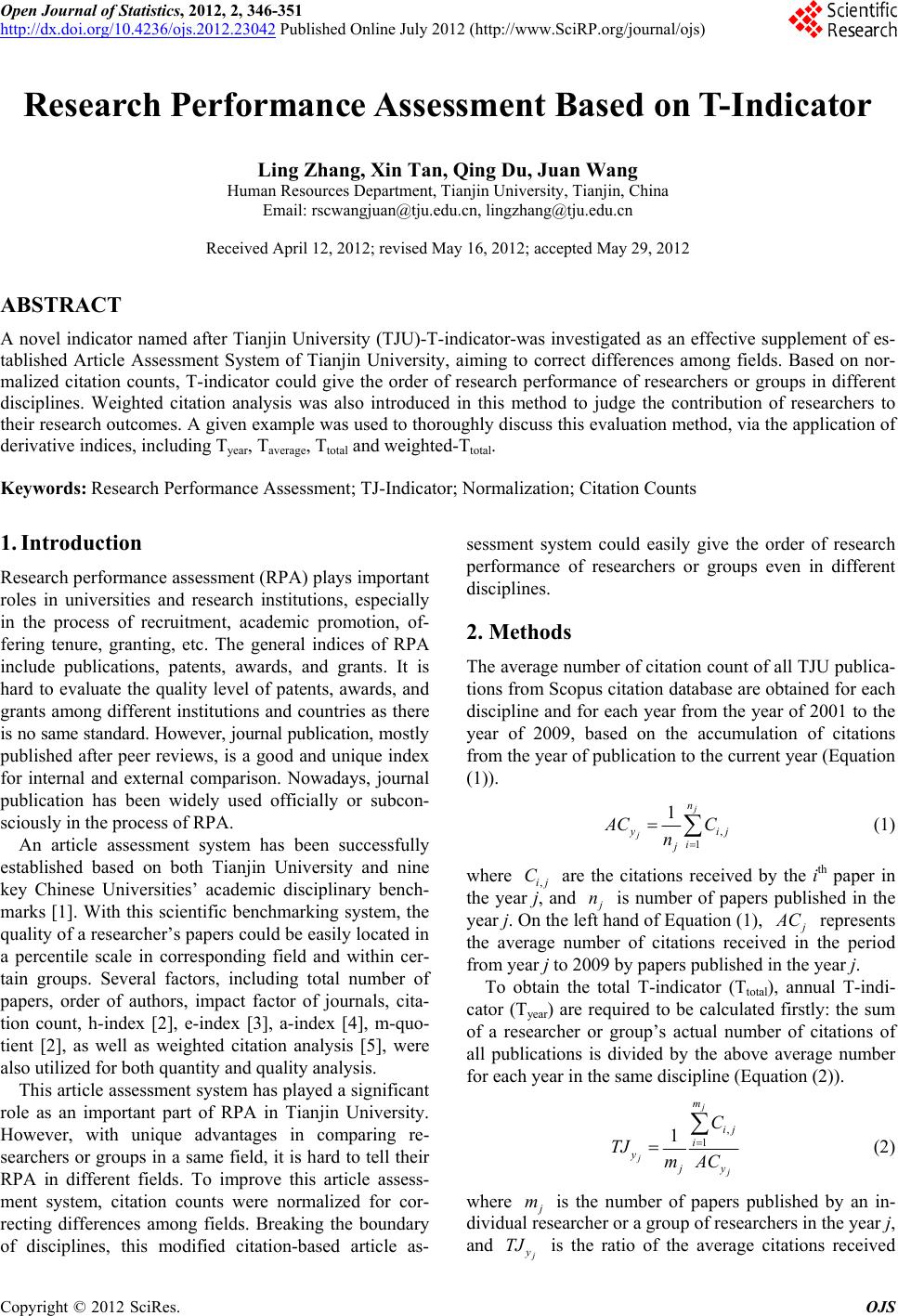
Open Journal of Statistics, 2012, 2, 346-351
http://dx.doi.org/10.4236/ojs.2012.23042 Published Online July 2012 (http://www.SciRP.org/journal/ojs)
Research Performance Assessment Based on T-Indicator
Ling Zhang, Xin Tan, Qing Du, Juan Wang
Human Resources Department, Tianjin University, Tianjin, China
Email: rscwangjuan@tju.edu.cn, lingzhang@tju.edu.cn
Received April 12, 2012; revised May 16, 2012; accepted May 29, 2012
ABSTRACT
A novel indicator named after Tianjin University (TJU)-T-indicator-was investigated as an effective supplement of es-
tablished Article Assessment System of Tianjin University, aiming to correct differences among fields. Based on nor-
malized citation counts, T-indicator could give the order of research performance of researchers or groups in different
disciplines. Weighted citation analysis was also introduced in this method to judge the contribution of researchers to
their research outcomes. A given example was used to thoroughly discuss this evaluation method, via the application of
derivative indices, including Tyear, Taverage, Ttotal and weighted-Ttotal.
Keywords: Research Performance Assessment; TJ-Indicator; Normalization; Citation Counts
1. Introduction
Research performance assessment (RPA) plays important
roles in universities and research institutions, especially
in the process of recruitment, academic promotion, of-
fering tenure, granting, etc. The general indices of RPA
include publications, patents, awards, and grants. It is
hard to evaluate the quality level of patents, awards, and
grants among different institutions and countries as there
is no same standard. However, journal publication, mos tly
published after peer reviews, is a good and unique index
for internal and external comparison. Nowadays, journal
publication has been widely used officially or subcon-
sciously in the process of RPA.
An article assessment system has been successfully
established based on both Tianjin University and nine
key Chinese Universities’ academic disciplinary bench-
marks [1]. With this scientific benchmarking system, the
quality of a researcher’s papers could be easily located in
a percentile scale in corresponding field and within cer-
tain groups. Several factors, including total number of
papers, order of authors, impact factor of journals, cita-
tion count, h-index [2], e-index [3], a-index [4], m-quo-
tient [2], as well as weighted citation analysis [5], were
also utilized for both quantity and quality analysis.
This article assessment system has played a significant
role as an important part of RPA in Tianjin University.
However, with unique advantages in comparing re-
searchers or groups in a same field, it is hard to tell their
RPA in different fields. To improve this article assess-
ment system, citation counts were normalized for cor-
recting differences among fields. Breaking the boundary
of disciplines, this modified citation-based article as-
sessment system could easily give the order of research
performance of researchers or groups even in different
disciplines.
2. Methods
The average number of citation count of all TJU publica-
tions from Scopus citation database are obtained for each
discipline and for each year from the year of 2001 to the
year of 2009, based on the accumulation of citations
from the year of publication to the current year (Equation
(1)).
,
1
1j
j
n
ij
i
j
CC
n
C
(1)
where ,ij
are the citations received by the ith paper in
the year j, and
n is number of papers published in the
year j. On the left hand of Equation (1),
C represents
the average number of citations received in the period
from year j to 2009 by papers published in the year j.
To obtain the total T-indicator (Ttotal), annual T-indi-
cator (Tyear) are required to be calculated firstly: the sum
of a researcher or group’s actual number of citations of
all publications is divided by the above average number
for each year in the same discipline (Equation (2)).
,
1
1
j
j
m
ij
i
yjy
C
TJ mAC
(2)
where
m is the number of papers published by an in-
dividual researcher or a group of researchers in the year j,
and
TJ is the ratio of the average citations received
C
opyright © 2012 SciRes. OJS